Les Consultations de Nourrissons
Infant mortality was fierce in the 19th and early 20th century, especially among non-breast-fed infants, due to contaminated milk supplies, diarrhea, respiratory diseases, and other contagious illnesses. In France, as well as many other countries, this caused great concern from the standpoint of potentially declining population’s effect on the armies in the face of aggressive neighboring countries. Among his many other contributions to the art and science of newborn care at the turn of the 20th Century, Pierre Budin established clinics and consultations for mothers and newborns after their discharge from the hospital, advocating breastfeeding whenever possible, and pasteurization of milk when breastfeeding was not possible. Subsequently, this practice was widely adopted and clinics were opened throughout France and elsewhere in Europe.
“During the early 1890s, infantile diarrhea, caused by bottle-feeding cow’s milk to infants, contributed to infant mortality, often because the milk had not be properly pasturized. Budin insisted that breast milk from women was superior to milk substitutes for infants unless they couldn’t breastfeed. In 1892, Budin founded a system of clinics at the Hôpital de la Charité that supervised the care of infants after discharge from maternity hospitals. Budin established consultations in which he met with new mothers and encouraged them to breastfeed and to monitor their infants’ weights. To encourage regular attendance for consultations, Budin provided mothers with economic incentives and gifts.”
“Budin designed several items for new mothers and their infants. Budin designed a rubber nipple and developed a smaller version for infants with low birth weight who were unable to suckle. For women with premature infants, Budin created an apparatus that pumped milk from the breast, making breast milk more accessible for infants who were unable to suckle.” — The Embryo Project Encyclopedia
The press photos below show one of the Consultations for Newborns in Paris that was established by Budin in Paris.




Dr. Budin’s clinics are commemorated by a plaque at the Musée de l’Assistance Publique – Hôpitaux de Paris, located at 47, quai de la Tournelle, 75005 Paris, France.

The 1903 painting “L’OEuvre de la goutte de lait au dispensaire de Belleville” by Henri Jules-Jean Geoffroy, portraying a newborn clinic in Belleville, can be found in the same museum. Geoffrey was a well-known painter of children who put his art in the service of new ideas in medicine, in particular the recently developed area of pediatric specialization. The image was popularized across France through circulation of a postcard version. The clinic was founded by Dr. Gaston Variot, a pioneer of childcare and colleague of Louis Pasteur.

“The triptych structure gives the work the solemnity of a didactic image. The central position of Dr. Variot is of distinct importance; despite a somewhat crowded situation, he listens with full attention to a young mother while at the same time holding in his hand a card that records the child’s weight. Weighing newborns made possible the measurement of their regular growth.” — Medicine in Art, by Giorgio Bordin. Source: Google Books.
The Consultations received widespread attention in the popular press.
“Here are the facts. It is in the first moments of life that the individual is most threatened by death. Thus 1,000 children aged 0 to 1 years produce 202 deaths, while 1,000 adolescents (from 10 to 19 years) produce only 4…”
“Why is this so? This is because the older man, educated and shaped by experience, avoids many illnesses; but the child cannot. It presents a virgin ground to all infections, and they develop like fire on dry grass. Food is often a poison for it: spoiled milk or given with an unclean bottle or even incorrectly dosed, and too much soups cause a third of infant deaths through diarrhea. The rest are carried away by the cold and other ailments brought on by a bad diet. It is certain that most of these diseases are preventable and only develop through the ignorance of those – mothers and nurses – to whom the children belong, at their mercy…
“The late doctor Budin had found a practical and simple remedy for this lamentable situation. He organized an infant consultation at his clinic, where mothers came to get advice on the care to be given to their children. and the mortality of his small clients fell to a quarter of the general average for the city of Paris. The proof was made and was confirmed in the environments where this great initiative — of which Mr. Paul Strauss made himself the champion outside the medical circles – was adopted. it is this wise organization that the central power would like to spread everywhere, since everywhere the protection needs of children are the same. Doctor Potelet, the health and public hygiene inspector of the Nord department, who – with the Yonne department inspector Doctor Mocquot – showed the most firm activity to resolve the practical problem, and wrote a very precise set of instructions, from which we will profitably draw inspiration… ” — Le Revue, Paris, July 8, 1907.

- Professor Pierre Budin, 1846-1907
- Les Consultations de Nourrissons, by Dr. Pierre Budin
- Consultations de Nourrissons, by Mlle. Entz (thesis 1900)
- Le Nourrisson (French), by Dr. Pierre Budin.
- The Nursling (English Translation), by Dr. Pierre Budin
Last Updated on 03/30/24